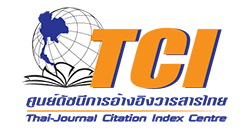การพัฒนารูปแบบองค์กรแห่งการเรียนรู้
Abstract
บทคัดย่อ การวิจัยนี้มีวัตถุประสงค์เพื่อ 1) ศึกษาสภาพของการเป็นองค์กรแห่งการเรียนรู้ 2) เพื่อศึกษาองค์ประกอบที่มีอิทธิพลต่อรูปแบบขององค์กรแห่งการเรียนรู้ 3) เพื่อพัฒนารูปแบบขององค์กรแห่งการเรียนรู้ กลุ่มตัวอย่างเป็นผู้บริหารโรงเรียนและครูของโรงเรียนสังกัดสำนักงาน เขตพื้นที่ 19 จำนวน 325 คน ที่ได้มาจาการสุ่มแบบแบ่งชั้น และเครื่องมือที่ใช้ในการวิจัยเป็นแบบสัมภาษณ์และแบบสอบถามเกี่ยวกับสภาพการเป็นองค์กรแห่งการเรียนรู้และองค์ประกอบที่มีอิทธิพลต่อการเป็นองค์กรแห่งการเรียนรู้ ใช้สถิติพื้นฐานได้แก่ ค่าเฉลี่ย (Mean) และค่าส่วนเบี่ยงเบนมาตรฐาน ( Standard Deviation) ค่าความเบ้ (Skerness) ค่าความโด่ง (Kutosis)และค่าสัมประสิทธิ์ความแปรผัน (coefficient of variance : CV) เพื่อทราบลักษณะการแจกแจง จากนั้นนำข้อมูลที่ได้มาวิเคราะห์โปรแกรมทางสถิติ SPSS,ExtractionFactor Analysis : Factor Extraction และการวิเคราะห์เนื้อหา (Content Analysis) ผลการวิจัยพบว่า 1) ระดับของการเป็นองค์กรแห่งการเรียนรู้ ในภาพรวมอยู่ในระดับมาก เรียงตามค่าเฉลี่ยจากมากไปหาน้อย ดังนี้ ด้านการเรียนรู้ ด้านเทคโนโลยี ด้านบุคลากร ด้านองค์การ และด้านการจัดการความรู้ 2) องค์ประกอบขององค์กรแห่งการเรียนรู้ที่มีอิทธิพลต่อสถานภาพ ประกอบด้วย 3 องค์ประกอบหลัก ได้แก่ ด้านองค์การ ด้านบุคคลกร และ ด้านผู้นำ โดยองค์ประกอบหลักด้านองค์การ ประกอบด้วย 4 องค์ประกอบย่อย ได้แก่ โครงสร้างองค์กร วิสัยทัศน์และกลยุทธ์ขององค์กร วัฒนธรรมองค์กร และเทคโนโลยีสารสนเทศ องค์ประกอบหลักด้านบุคลากร ประกอบด้วย 4 องค์ประกอบย่อย ได้แก่ องค์ความรู้ความสามารถของบุคลากร ความตั้งใจและทุ่มเทของบุคลากร แรงจูงใจและเจตคติในการทำงานของบุคลากร และ การทำงานร่วมกันเป็นทีม องค์ประกอบหลักด้านผู้นำ ประกอบด้วย 3 องค์ประกอบย่อย ได้แก่ ผู้นำที่ทำหน้าที่กระตุ้นส่งเสริม ผู้นำที่มุ่งนำการเปลี่ยนแปลง และ ผู้นำที่มีบทบาทเป็นผู้ร่วมงาน 3) รูปแบบขององค์การแห่งการเรียนรู้ ประกอบด้วย 3 องค์ประกอบหลัก องค์ประกอบหลักด้านองค์กร บุคคล และ ผู้นำ และ 8 องค์ประกอบย่อย โดยองค์ประกอบหลัก 1) ด้านองค์กร ประกอบด้วย 3 องค์ประกอบย่อย คือ โครงสร้างองค์กรและการบริหารจัดการ วิสัยทัศน์และกลยุทธ์องค์กร เทคโนโลยีสารสนเทศและวัฒนธรรม 2) องค์ประกอบหลักด้านบุคคล ประกอบด้วย 3 องค์ประกอบย่อยคือ ความรู้ความสามารถและตั้งใจทุ่มเทของบุคลากร ทักษะการทำงานร่วมกัน แรงจูงใจและเจตคติ 3) องค์ประกอบหลักด้านผู้นำ ประกอบด้วย 2 องค์ประกอบย่อยคือ ผู้นำที่มุ่งนำการเปลี่ยนแปลงและทำหน้าที่กระตุ้นส่งเสริม ผู้นำที่มีบทบาทเป็นผู้ร่วมงาน คำสำคัญ: รูปแบบองค์กรแห่งการเรียนรู้ Abstract The purposes of this study were to 1) study the conditions of school’s Learning Organization under The office of Education service area 19 2) the components the model of Learning Organization affecting the current status 3) develop the model of Learning Organization. The samples used in this research were School directors and teachers of schools under the office of Education service area 19, with the total number of 325. The instruments used were in-depth interview, focus group and questionnaires with regarding components of Learning Organization model. The statistics used were frequency, percentage, mean, standard deviation, skewness, kurtosis, coefficient of variance, extraction factor analysis. The finding revealed that 1) the conditions of school’s Learning Organization as a whole were at the good level, ranking from the highest mean as followed learning aspect, technology aspect, personnel aspect, organization aspect and knowledge management aspect. 2) the components the model of Learning Organization affecting the current status, which were consisted of three majors components 1) organization aspect with 4 minor components which were management, vision strategy, organization culture and technology information system 2) personnel aspect with four minor components which were job performance, personnel knowledge skill, personnel’s attitudes and team work skills and 3) leadership aspect with three minor components which were stimulant- like leader, transformational leadership and colleague -like leadership 3) develop the model of Learning Organization of schools under the office of Education service area 19 acquired by exploratory factor analysis : factor extraction, varimax with Kaiser normalization consisted of organization aspect, personnel aspect and leadership aspect were well fitted with the empirical knowledge data considering the model of learning organization with the three major components 8 minor components which were 1) organization aspect with 3 minor components which were management, vision strategy and organization culture technology information system 2) personnel aspect with three minor components which were job performance personnel knowledge skill, team work skills and personnel’s attitudes 3) leadership aspect with two minor components which were stimulant transformational leadership and colleague -like leadership. Keyword : Learning Organization Model ������������������������������������������������������������������������������������������������������������������������������������������������������������������������������������������������������������������������������������������������������������������������������������������������������������������������������������������������������������������������������������������������������������������������������������������������������������������������������������������������������������������������������������������������������������������������������������������������������������������������������������������������������������������������������������������������������������������������������������������������������������������������������������������������������������������������������������������������������������������������������������������������������������������������������������������������������������������������������������������������������������������������������������������������������������������������������������������������������������������������style='font-size:14.0pt;font-family:"Browallia New","sans-serif";color:black'>in each, and overall aspects was rate at the “much” and higher than the set criteria at the level of 0.05 was statistically significant. Keyword: academic services of higher education institutions, enhancement of learningDownloads
Download data is not yet available.
Downloads
Issue
Section
บทความวิจัย




